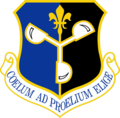|
20th Operational Weather Squadron
The 20th Operational Weather Squadron which provided forecasts for the Air Force and Army in Japan and South Korea, is now inactive following the transfer of its mission to Hickam Air Force Base, Hawaii on 17 April 2006. MissionUntil its inactivation in April 2006, the 20th Operational Weather Squadron was responsible for producing and disseminating mission planning and execution weather analyses, forecasts, and briefings for Air Force, Army, Navy, Marines, Guard, Reserve, USFK, PACOM, PACAF, USAPRAC, SOCPAC, and NAVPAC forces operating at 115 installations/sites over 5.2 million sq.mi. within the Pacific theater of operations. This weather squadron was responsible for base or post forecasting, developing weather products, briefing transient aircrews, and weather warnings for all of their geographical units. Using automatic observing systems located at all military installations and communicating with their combat weather flights, the squadron was able to 'watch' the weather in their entire area of responsibility from one central location. The Operational Weather Squadron was the first place a newly schooled weather apprentice would report. At the squadron, working alongside a seasoned weather professional, the forecaster was trained in all aspects of Air Force meteorology, from pilot briefing to tactical forecasting. The weather squadron worked closely with the combat weather flights they support to ensure a flawless exchange of weather information. Personnel and resources20th Operational Weather Squadron's manning consisted of active duty, reserve, civilian and contract personnel and was located on Yokota Air Base, Japan, Under the Fifth Air Force, Yokota Air Base, Japan. LineageActivations and Inactivations of the 20th Weather Squadron, and 20th Operational Weather Squadron.
Duty AssignmentsList of duty assignments and parent units from 1943 to present.
Emblem
HistoryThe 20th Weather Squadron activated at Cairo, Egypt, on 15 April 1943, and was assigned to the Ninth Air Force, but was soon thereafter disbanded on 31 October 1943. The Army Air Forces again activated the 20th on 6 December 1944, on Biak Island in what was then known as the Netherlands East Indies, today's Indonesia. The 20th absorbed the resources and mission of the 5231st Weather Squadron (Provisional). The 20th was assigned to the Far East Air Forces Weather Group (Provisional) at that time. In May 1945 the squadron moved its headquarters by from Biak Island to Fort William McKinley near Manila, Philippines. By the close of July 1945, the squadron had grown to more than 700 men and the headquarters was overseeing the work of 34 weather stations, many of which were in isolated locations. The Army Air Forces Weather Service assumed control of all weather organizations on 1 July 1945, and organized the 20th under the 1st Weather Group on 20 September 1945. Due to congested quarters at Fort William McKinley, the 20th's headquarters moved again in August 1945 to nearby Nichols Field. While headquartered in the Philippines, the 20th lost two men to combat action. Following the capitulation of Japan, the 20th began its long association with Japan. The squadron moved its headquarters to Tokyo on 2 November 1945, and accompanied Headquarters, Fifth Air Force to Nagoya on 22 May 1946. War demobilization caused the 20th to lose personnel rapidly. To accomplish its growing mission, the 20th hired local nationals, employed non-weather officers to oversee some weather stations, and began on the-job schools to cross-train enlisted men into weather career fields. By late 1946, the 20th was operating weather stations in Japan, China, and Korea. The 20th relinquished control of the China stations in 1947 and the last Korean station was closed in 1949. The squadron came under the leadership of the 2143d Air Weather Wing in 1949. Within three days of North Korean troops crossing into South Korea in June 1950, a detachment of the 20th Weather Squadron was airlifted to Daegu, Korea. The leadership of the 20th Weather Squadron was soon burdened by the growth of detachments both in Korea and Japan to support the war effort. By early November 1950, the 20th was overseeing 27 detachments, eight of which were in Korea, where, on average, one of these detachments relocated every five days. The Air Force activated the 30th Weather Squadron to oversee Korean operations, but the 20th remained deeply involved in the war effort. The 20th was assigned to the newly activated 1st Weather Wing in 1954. The squadron was inactivated on 18 February 1957, but emerged anew at Fuchu Air Station, Japan, on 8 June 1964, where it remained until 1974 when it relocated to Yokota Air Base. Again, it was inactivated in 1976 as part of an Air Weather Service reorganization only to return at Yokota on 1 January 1985. As part of the divestiture of Air Weather Service, the 20th was assigned to Pacific Air Forces in 1991. It relocated to Hickam Air Force Base, Hawaii, on 1 April 1992, and was inactivated on 1 June. With the reengineering of the Air Force Weather Agency the 20th was redesignated an Operational Weather Squadron on 13 July 2000, and activated on 1 October. It was assigned to Fifth Air Force and stationed again at Yokota Air Base, Japan. Recent historyThe 20th Operational Weather Squadron became inactive on 17 April 2006 when its mission was transferred to the 17th Operational Weather Squadron at Hickam Field, Hawaii. Awards
External links |
